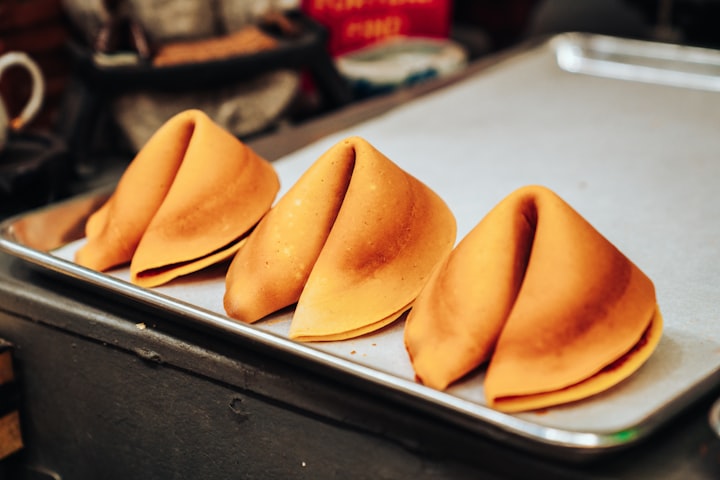Munchie With A Message
Origins of the Fortune Cookie __ From Kyoto to California

In the world of culinary delights, there exists a delicacy that transcends mere taste and ventures into the realm of mystique and fortune. The humble yet enigmatic fortune cookie has captured the imagination of millions worldwide, but its origins trace back to a fascinating journey from the ancient streets of Kyoto to the bustling shores of California.
Our story begins in the vibrant city of Kyoto, Japan, where time seems to dance between the past and the present. It was here, amidst the cherry blossoms and traditional tea houses, that a small family-owned bakery nestled within the narrow lanes of the historic Gion district. The aroma of freshly baked goods wafted through the air, drawing in passersby with promises of sweet delights.
Among the bakery's many offerings was a simple yet beloved treat known as tsujiura senbei. These crispy, lightly sweetened crackers, made from a blend of rice flour, sugar, and sesame seeds, were a staple of Kyoto's culinary landscape. Families would gather around the hearth to enjoy them during festive occasions, while travelers savored them as a taste of local tradition.
The origins of tsujiura senbei can be traced back centuries, with some claiming that it was first crafted by a wise old baker who imbued each cracker with a sprinkle of magic and a dash of fortune. Legends spoke of hidden messages concealed within the senbei, offering guidance and wisdom to those who were fortunate enough to discover them.
Now, let us fast forward to the dawn of the 20th century and cross the vast Pacific Ocean to the shores of California. As waves of Japanese immigrants sought new opportunities in the land of the free, they carried with them not only their hopes and dreams but also the rich tapestry of their culinary heritage.
Among these immigrants was Makoto Hagiwara, a skilled landscape designer who found solace and inspiration amidst the natural beauty of San Francisco's Golden Gate Park. Entrusted with the care of the park's iconic Japanese Tea Garden, Hagiwara poured his heart and soul into transforming it into a tranquil oasis of serenity and contemplation.
It was amidst the serene beauty of the garden that Hagiwara found himself pondering the creation of a unique souvenir for visitors to take home. Drawing upon his Japanese roots and the flavors of his homeland, he sought to reinvent the traditional tsujiura senbei, infusing it with a touch of novelty and intrigue.
And thus, the fortune cookie was born.
Crafted from a delicate mixture of flour, sugar, and vanilla, the fortune cookie bore little resemblance to its humble predecessor. Its thin, crispy shell concealed a hidden treasure—a slip of paper bearing words of wisdom, prophecy, or whimsy. Each cookie was a surprise waiting to be unwrapped, a tiny capsule of hope and possibility.
These early fortune cookies quickly became a sensation among visitors to the Japanese Tea Garden. People marveled at both the taste of the cookies and the intrigue of the fortunes hidden within. Some believed them to be messages from the gods, while others saw them as a playful twist on tradition.
However, it's essential to recognize that the fortune cookie's journey did not end within the confines of Golden Gate Park. As Chinese immigrants began to establish themselves in communities across the United States, they embraced the fortune cookie as a symbol of good luck and prosperity.
Chinese restaurants, in particular, played a significant role in popularizing the fortune cookie, incorporating it into their menus as a sweet conclusion to a savory meal. Diners eagerly cracked open the cookies, delighting in the anticipation of discovering their fortune and sharing it with friends and loved ones.
From there, the fortune cookie's fame spread like wildfire, finding its way onto dinner tables and into fortune seekers' hands across the globe. Its transformation from a humble Japanese snack to an iconic symbol of fortune and mystery is a testament to the power of cultural exchange and culinary innovation.
Today, as we crack open these crisp confections and eagerly unravel the messages hidden within, let us not forget the rich tapestry of history and tradition from which they emerged. The origins of the fortune cookie remind us that even the simplest of treats can carry with them a story as vast and profound as the human experience itself. And as we savor each bite, let us embrace the magic and wonder of the journey that brought them to our table.
About the Creator
Alison Cloveheart
Hey there!
I'm an aspiring writer, who wants to be better connected with all the readers out there and for some much needed feedback.
^_^






Comments
There are no comments for this story
Be the first to respond and start the conversation.